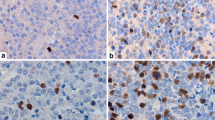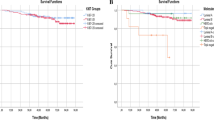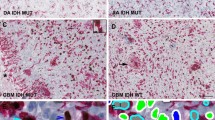Summary
The aim of this study was to determine possible relationships between Ki-67 labelling index (Ki-67 LI), amplification of the epidermal growth factor receptor (EGFR) gene, and prognosis in human glioblastomas. Ki-67 LI was determined on cryosections of biopsy specimens of 20 human glioblastomas with a mouse antihuman Ki-67 monoclonal antibody. Amplification of the EGFR gene was determined by slot blot and Southern blot analyses of DNA extracted from the tumour biopsies. The Ki-67 LI was higher in the glioblastoma group with EGFR gene amplification (8 tumours, median value of Ki-67 LI 4.2, range 0.4–24.6) than in those without EGFR gene amplification (12 tumours, median value of Ki-67 LI 0.8, range 0.2–11.8) (0.05 p<0.1). The glioblastoma patients with Ki-67 LI>1.5 (10 tumours) had a statistically significant shorter survival than those with Ki-67 LI<1.5 (10 tumours) (p<0.05). The glioblastoma patients with EGFR gene amplification lived shorter time than those without EGFR gene amplification (p>0.05).
Similar content being viewed by others
References
Aasland R, Olsen LC, Spurr NK, Krokan HE, Helland DE (1990) Chromosomal assignment of human uracil-DNA glycosylase to chromosome 12. Genomics 7: 139–141
Bigner SH, Burger PC, Wong AJ, Werner MH, Hamilton SR, Muhlbaier LH, Vogelstein B, Bigner DD (1988) Gene amplification in malignant human gliomas: clinical and histopathologic aspects. J Neuropathol Exp Neurol 47: 191–205
Brown DC, Gatter KC (1990) Monoclonal antibody Ki-67: its use in histopathology. Histopathol 17: 489–503
Burger PC, Shibata T, Kleihues P (1988) Proliferation markers for neoplasms of the nervous system. In: DeLellis RA (eds) Advances in immunohistochemistry. Raven Press, New York, pp 301–316
Church GM, Gilbert W (1984) Genomic sequencing. Proc Acad Natl Sci USA 81: 1991–1995
Deckert M, Reifenberger G, Wechsler W (1989) Determination of the proliferative potential of human brain tumors using the monoclonal antibody Ki-67. J Cancer Res Clin Oncol 115: 179–188
Downs TR, Wilfinger WW (1983) Fluorometric quantification of DNA in cells and tissue. Analyt Biochem 131: 538–547
Ekstrand AJ, James CD, Cavenee WK, Seliger B, Petterson RF, Collins VP (1991) Genes for epidermal growth factor receptor, transforming growth factor α, and epidermal growth factor and their expression in human gliomas in vivo. Cancer Res 51: 2164–2172
Gerdes J, Schwab U, Lemke H, Stein H (1983) Production of a mouse monoclonal antibody reactive with a human nuclear antigen associated with cell proliferation. Int J Cancer 31: 13–20
Gerdes J, Lemke H, Baisch H, Wacker H-H, Schwab U, Stein H (1984) Cell cycle analysis of a cell proliferation-associated human nuclear antigen defined by the monoclonal antibody Ki-67. J Immunol 133: 1710–1715
Giangaspero F, Doglioni C, Rivano MT, Pileri S, Gerdes J, Stein H (1987) Growth fraction in human brain tumors defined by the monoclonal antibody Ki-67. Acta Neuropathol (Berl) 74: 179–182
Helseth E, Unsgaard G, Dalen A, Fure H, Skandsen T, Ødegaard A, Vik R (1988) Amplification of the epidermal growth factor receptor gene in biopsy specimens from human intracranial tumours. Br J Neurosurg 2: 217–225
Helseth E, Brøgger A, Dalen A, Fure H, Greff Johansen S, Eknæs Lier M, Skandsen T, Unsgaard G, Vik R (1990) Polysomy of chromosome 7 is associated with amplification and overexpression of the EGF-receptor gene in a human carcinoma cell line derived from a brain metastasis. APMIS 98: 996–1004
Hoshino T, Prados M, Wilson CB, Cho KG, Lee K-S, Davis RL (1989) Prognostic implications of the bromodeoxyuridine labeling index of human gliomas. J Neurosurg 71: 335–341
Libermann TA, Razon N, Bartal AD, Yarden Y, Schlessinger J, Soreq H (1984) Expression of epidermal growth factor receptors in human brain tumours. Cancer Res 44: 753–760
Libermann TA, Nusbaum HR, Razon N, Kris R, Lax I, Soreq H, Whittle N, Waterfield MD, Ullrich A, Schlessinger J (1985) Amplification, enhanced expression, and possible rearrangement of EGF receptor gene in primary human brain tumours of glial origin. Nature 313: 144–147
Maruno M, Kovach JS, Kelly PJ, Yanagihara T (1991) Transforming growth factor-α, epidermal growth factor receptor, and proliferating potential in benign and malignant gliomas. J Neurosurg 75: 97–102
Morimura T, Kitz K, Stein H, Budka H (1991) Determination of proliferative activities in human brain tumour specimens: a comparison of three methods. J Neuro=Oncol 10: 1–11
Olsen LC, Aasland R, Wittwer CU, Krokan HE, Helland DE (1989) Molecular cloning of human uracil-DNA glycosylase, a highly conserved DNA repair enzyme. EMBO J 8: 3121–3125
Ostertag CB, Volk B, Shibata T, Burger P, Kleihues P (1987) The monoclonal antibody Ki-67 as a marker for proliferating cells in stereotactic biopsies of brain tumours. Acta Neurochir (Wien) 89: 117–121
Patsouris E, Stocker U, Kallmeyer V, Keiditsch E, Mehraein P, Stavrou D (1988) Relationship between Ki-67 positive cells, growth rate, and histological type of human intracranial tumors. Anticancer Res 8: 537–544
Pigott TJD, Lowe JS, Palmer J (1991) Statistical modelling in analysis of prognosis in glioblastoma multiforme: a study of clinical variables and Ki-67 index. Br J Neurosurg 5: 61–66
Quinn CM, Wright NA (1990) The clinical assessment of proliferation and growth in human tumours: evaluation of methods and applications as prognostic variables. J Pathol 160: 93–102
Torp SH, Helseth E, Dalen A, Unsgaard G (1991) Epidermal growth factor receptor expression in human gliomas. Cancer Immunol Immunother 33: 61–64
Velu TJ (1990) Structure, function, and transforming potential of the epidermal growth factor receptor. Mol Cell Endocrinol 70: 205–216
Xu Y-H, Ishii S, Clark AJL, Sullivan M, Wilson RK, Ma DP, Roe BA, Merlino GT, Pastan I (1984) Human epidermal growth factor receptor cDNA is homologous to a variety of RNAs overproduced in A431 carcinoma cells. Nature 309: 806–810
Zuber P, Hamou M-F, de Tribolet N (1988) Identification of proliferating cells in human gliomas using the monoclonal antibody Ki-67. Neurosurgery 22: 364–368
Zülch KJ (1979) Histological typing of tumours of the central nervous system. In: International Histological Classification of Tumours, No 21. World Health Organization, Geneva
Author information
Authors and Affiliations
Rights and permissions
About this article
Cite this article
Torp, S.H., Helseth, E., Dalen, A. et al. Relationships between Ki-67 labelling index, amplification of the epidermal growth factor receptor gene, and prognosis in human glioblastomas. Acta neurochir 117, 182–186 (1992). https://doi.org/10.1007/BF01400618
Issue Date:
DOI: https://doi.org/10.1007/BF01400618




